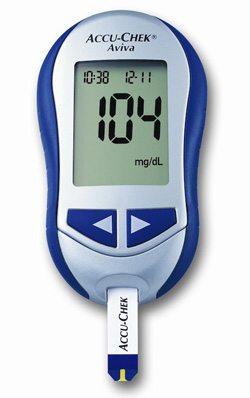
When you get a new blood glucose meter, you need to determine if it is consistent.
Everyone who has diabetes has to rely on this little home medical device. It is a quick and easy way for you to find out if the food you are eating, the activity you are getting, the medicine and supplements that you use, and the amount of stress that you face are making your blood glucose level dangerously high or low.
Like any medical device, your blood glucose meter isn’t perfect. The U.S. Food and Drug Administration sets their standards and approves which blood glucose meters may be sold to the American public. But the FDA doesn’t set the highest possible standards, so the manufacturers of blood glucose meters naturally compete largely on the basis of price.
The ball is in your court
This leaves it largely up to you to determine how good your meter is. Every so often researchers will check out some meters, and when they do I report here on their findings. But even the researchers can’t check all of the blood glucose meters, and when they get their studies published, the meters they evaluate may not be for sale in the country where you live or even be made any more.
You can’t check the accuracy of your blood glucose meter without either sending specimens of your blood to a lab or checking the meter against the gold standard of meter accuracy, the Hemocue. But in the United States that meter is still only available to health professionals, and either way is expensive.
You can check consistency
But you can check the consistency of your blood glucose results. Your blood glucose meter’s consistency, which is also called precision or reproducibility, may actually be even more important than its accuracy. If it isn’t accurate but is consistent, it will usually tell you that your blood glucose level is a little lower or higher than it really is. But if it gives inconsistent results, you can be in serious trouble, particularly if you inject insulin. If you relied on a false high measurement, you could then react by taking far too much insulin that could put you into a diabetic coma or even have a potentially fatal result.
“It is easy to check for the consistency of your meter in the normal range, from 70 mg/dl (3.9 mmol/l) to 110 mg/dl (6.2 mmol/l),” Richard K. Bernstein, M.D., told me a few days ago. That is what he checks and recommends that you check. He says that most of his patients have blood glucose levels in that range.
Dr. Bernstein himself was diagnosed with type 1 diabetes in 1946 at the age of 12. Since January 1970, when he became the first person with diabetes to obtain a blood glucose meter, he has been able to keep his A1C level around 4.5.
Make five checks at normal levels
But Dr. Bernstein also told me that even excellent meters can be inconsistent at high blood glucose levels. “The higher you go, the less consistent your meters will be.”
You can check your meter’s consistency by doing five fingerstick tests in a row. “Not just one or two tests,” he cautions.
Dr. Bernstein checks the consistency of the meters that he and his patients use. On this basis he currently recommends one of Abbott’s FreeStyle Lite or FreeStyle Freedom Lite meters.
Everything changes
Eight years ago I checked the consistency of a FreeStyle Freedom Lite meter when it first became available and reviewed it here. At that time I checked my blood glucose level on each of my 10 fingers within 20 minutes, and got wildly different results.
But manufacturers can and do change their meters without changing what they name them. In particular, they do change the test strips that their meters use. That seems to be what Abbott did in this case, or maybe the particular vial I got was mishandled.
The message here is to check your meter’s consistency. And not just when it’s new, but whenever you get a new vial of test strips.
This article is based on an earlier version of my article published by HealthCentral.
Never Miss An Update
Subscribe to my free newsletter “Diabetes Update”
I send out my newsletter on first of every month. It covers new articles and columns that I have written and important developments in diabetes generally that you may have missed.


I’m retired military and for the most part are dictated what they carry in the pharmacy. I love Accu-Chek but little pricey compared to cost of issue ones, free. For the longest time I’ve used Precision Xtra but before my reg doc left, she asked me to try FreeStyle Freedom Lite and so Precision is home and FreeStyle is on the road with me. Haven’t done a rigid test comparison but both seem fairly close in my readings and how I feel. Now I might think she knew something. This doc is very smart. Again always look for your emails. Thank you.
“Eight years ago I checked the consistency of a FreeStyle Freedom Lite meter when it first became available and reviewed it here. At that time I checked my blood glucose level on each of my 10 fingers within 20 minutes, and got wildly different results.”
OK, so what is considered wildly different …..how many points difference should we consider poor, fair, good, excellent?
“Widely different” is a phrase that I don’t know how to express with objective numbers, Sue. Sorry.